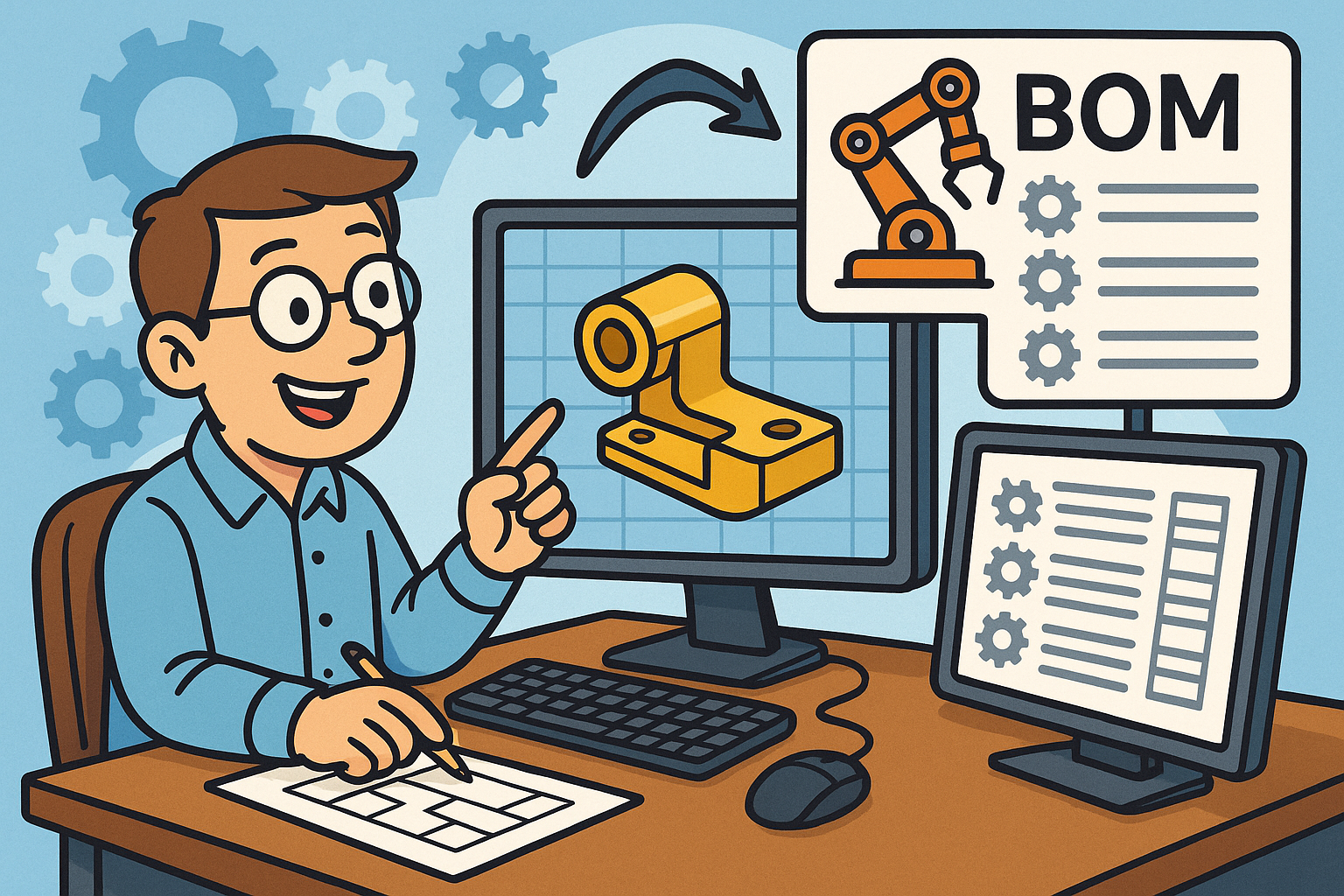Your Cart is Empty
Customer Testimonials
-
"Great customer service. The folks at Novedge were super helpful in navigating a somewhat complicated order including software upgrades and serial numbers in various stages of inactivity. They were friendly and helpful throughout the process.."
Ruben Ruckmark
"Quick & very helpful. We have been using Novedge for years and are very happy with their quick service when we need to make a purchase and excellent support resolving any issues."
Will Woodson
"Scott is the best. He reminds me about subscriptions dates, guides me in the correct direction for updates. He always responds promptly to me. He is literally the reason I continue to work with Novedge and will do so in the future."
Edward Mchugh
"Calvin Lok is “the man”. After my purchase of Sketchup 2021, he called me and provided step-by-step instructions to ease me through difficulties I was having with the setup of my new software."
Mike Borzage
5 PTC Creo Features Revolutionizing Collaborative Engineering Workflows
August 28, 2025 6 min read


Collaboration has evolved from optional advantage to baseline expectation. Distributed engineering teams, compressed schedules, and interconnected supply chains call for workflows that share data instantly, maintain context, and preserve intent. The paragraphs that follow examine five PTC Creo capabilities that remove the most persistent friction in that journey.
Windchill PLM Integration
At the heart of effective collaboration lies the ability to trust what everyone is looking at. Windchill operates as a centralized data vault, automatically capturing every model, drawing, and bill of materials as they mature. Because the vault is authoritative, engineers no longer wonder whether a Thursday‐morning screenshot reflects last night’s late-hour change or last month’s abandoned concept.
Traditional file servers rely on naming conventions to separate WIP from released data—an approach that fails once human discipline wavers. Windchill removes that weakness by weaving automated version and revision control directly into day-to-day Creo commands. Saving geometry produces a new iteration, and promoting geometry generates a formal revision. Browsing a component history shows exactly who modified what and why, so chasing down context through email disappears.
Modern programs rarely sit in a single building. Role-based access ensures that design partners across continents view only the models aligned with their contractual scope, while change-management workflows route tasks to stakeholders with digital signatures and escalation paths. This structure satisfies ISO and FDA traceability mandates without forcing engineers to become document clerks.
Progress transparency drives better decisions, so Windchill dashboards surface live project status and KPIs. Whether the metric is mass roll-up, open change notices, or upcoming gate reviews, everyone sees the same graph at the same point in time. That eliminates “just for you” slide decks and reduces status meetings to exception handling.
A frequently overlooked best practice is to configure promotion workflows that automatically trigger design reviews on specific maturity states. Instead of an email plea—“Could someone please look at Rev B?”—the vault itself assigns reviewers, sets deadlines, and logs their approvals alongside the CAD objects. Quality groups gain a complete audit trail, and engineers regain hours they formerly spent chasing signatures.
Unite Technology for Multi-CAD Collaboration
No single OEM dictates the entire toolchain anymore. A typical assembly may combine sheet-metal from a supplier who uses SolidWorks, molded housings from an Inventor shop, and electronics placeholders coming out of NX. The historic answer—STEP or IGES translation—breaks associativity and fosters obsolete geometry. Creo’s Unite Technology opens foreign CAD files natively, so the solid body remains true to its source without cumbersome mid-process conversions.
Maintaining associativity across CAD systems transforms behavior. Imagine a vendor updating a flange thickness in CATIA. When the new file arrives, the Creo assembly refreshes automatically, letting downstream interference checks, mass properties, and drawing views update in a single regeneration. Mechanical leads no longer discover late collisions because of stale reference models.
Where projects demand the reverse path, the optional Collaboration Extension saves geometry back into the originating format. That bidirectional route avoids the awkward loop in which suppliers recreate changes manually or build error-prone overlay models.
With translators removed, IT administrators discover they no longer maintain a zoo of conversion utilities, license servers, and automation scripts. That reduction lowers cost and risk each time an upstream vendor upgrades software.
There is, however, a practical consideration: When change frequency spikes—common during concept sprints—automatic geometry updates can interrupt focus every few minutes. Setting update notifications to “manual” during high-flux intervals grants designers control over when the floodgates open, combining stability with data integrity.
- Open without translate: Load SolidWorks, CATIA, NX, Inventor, and neutral formats directly into Creo assemblies.
- Propagate changes: Source-file edits ripple to downstream references without recreating constraints.
- Return to sender: Export back to the native platform so partners stay within their familiar toolset.
Creo View with Markup & Model-Based Definition (MBD)
Collaboration often involves people who do not design but still influence design. Purchasing needs mass roll-ups, quality needs tolerances, suppliers need critical dimensions, and finance wants capital cost visibility. Expecting each group to master full-blown CAD is unrealistic. Creo View delivers lightweight visualization of huge assemblies that opens on hardware as modest as a business laptop.
Once loaded, participants redline, comment, and annotate directly on 3D geometry or derived 2D drawings. Because comments embed in the viewable rather than living in separate spreadsheets, context travels with geometry. Quality inspectors capture measurement discrepancies; manufacturing engineers tag required clearances; project managers record questions—all without altering authoritative CAD.
Model-Based Definition extends the value by publishing Product Manufacturing Information (PMI) and GD&T into the same neutral viewable. Downstream teams consume tolerances without waiting for or misinterpreting separate PDF drawings. This single source of design intent shaves weeks off first-article approvals and reduces scrap due to ambiguous specs.
A cross-platform viewer allows external partners to access data without a full Creo license, ensuring that cost or IT policy never blocks visibility. When greater reach is needed, engineers export viewables as HTML5 packages. The recipient opens a browser, rotates the assembly, and inspects annotations in a zero-install environment.
- Embed redlines in the neutral file so comments cannot be separated from geometry.
- Attach measurement queries that highlight impacted faces, which speeds response time from engineering.
Augmented Reality Design Share
Design reviews traditionally meant conference rooms and PowerPoint fly-throughs. Augmented Reality (AR) removes that abstraction by placing the virtual product into the physical world. Within Creo, a single command publishes an AR experience to the secure cloud. The resulting session is referenced through a URL or QR code—no CAD skills required.
Stakeholders use iOS, Android, or Microsoft HoloLens devices to view scaled or full-size models. Walking around a digital turbine inside the factory bay reveals spatial conflicts that cannot be sensed on a 2D monitor. Service technicians overlay a gear housing onto an existing machine, verifying wrench clearances before the first casting exists.
What amplifies collaboration is live annotation and voice feedback. During a virtual design review, a manufacturing engineer can circle an unreachable bolt in mid-air while verbally describing alternative fastening. That markup synchronizes back to Creo and optionally stores in Windchill, ensuring feedback enters the formal change process.
Distribution simplicity encourages participation. A QR code printed on a drawing, pasted into a chat, or embedded in a SharePoint page lowers the barrier for finance, marketing, or field service teams. Because the viewer employs device cameras and inertial sensors, accurate tracking is achieved without external markers or complex calibration.
One common workflow involves on-site maintenance planning. Technicians arrive at a customer facility, scan a QR code, and see the proposed upgrade assembly merged with the legacy equipment. Clearances, hose routings, and human ergonomics become obvious, shortening downtime estimates and building end-user confidence.
Creo Simulation Live & Generative Design in the Cloud
The hand-off between design and analysis introduces delay each time a question arises. Creo Simulation Live addresses that chore by embedding Ansys solvers directly in the modeling window. Designers sketch a rib, push a fillet, or thin a wall, and within seconds see fresh stress, thermal, or modal plots. This real-time FEA compresses the iteration loop from days to minutes.
When goals shift toward weight optimization or organic load paths, cloud-based Generative Design takes the helm. Engineers specify envelope, loads, constraints, and target manufacturing processes, then launch an exploratory study that returns multiple viable concepts. Each proposal includes a scorecard covering stiffness, mass, and safety factor, giving the team an objective trade-space rather than a single “best guess.”
Collaboration reaches new depth through simultaneous simulation sessions. An analyst connects remotely, monitors the live study on their screen, and directs design tweaks while the solver recalculates. The flow mirrors pair programming in software engineering, turning FEA into a shared conversation instead of a serial task.
Governance still matters. Storing simulation studies within Windchill ties validation artifacts to the exact geometry revision they certify. Audit readiness improves, and engineers avoid the risky shortcut of reusing outdated results on new geometry just because “it looked close.”
- Instant feedback encourages early exploration and discourages late design churn.
- Cloud compute parallelizes multiple generative branches while local machines remain responsive.
- Traceable studies anchor analysis data to configured baselines for regulatory or customer scrutiny.
Conclusion
The five capabilities explored above resolve collaboration pain along the entire product-development continuum:
Windchill PLM integration secures data and drives process governance. Unite Technology demolishes multi-CAD silos. Creo View with MBD democratizes visual communication. Augmented Reality Design Share injects immersive understanding. Simulation Live and Generative Design accelerate iterative validation. Together they shorten time to consensus, lower the probability of rework, and empower geographically distributed talent to act as a unified team.
Rather than attempt a wholesale transformation, select one or two capabilities that address the loudest current bottleneck—perhaps native multi-CAD references or live simulation feedback—and measure reductions in decision latency and error count. The empirical gains will make a compelling business case to expand the toolkit across subsequent programs.
Also in Design News

Revolutionizing CAD: Automated BOM Generation for Enhanced Precision and Efficiency
August 28, 2025 10 min read
Read More
Cinema 4D Tip: Effective Use of the Morph Tag in Cinema 4D for Smooth Shape Transitions
August 28, 2025 3 min read
Read MoreSubscribe
Sign up to get the latest on sales, new releases and more …



